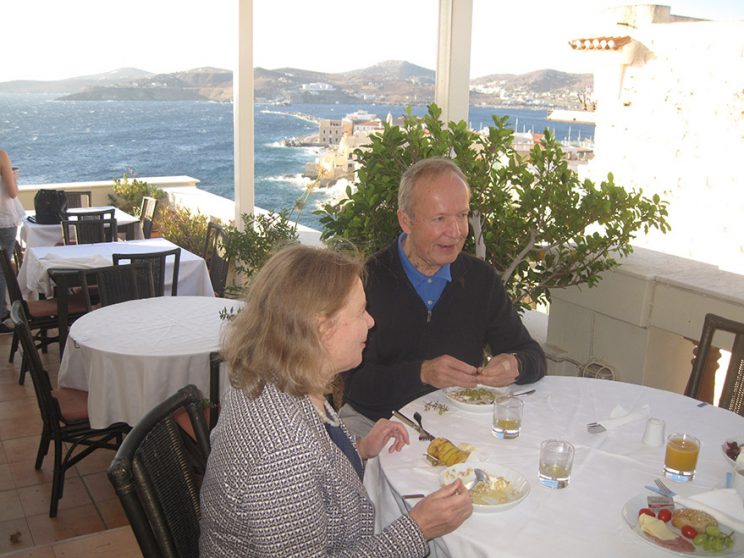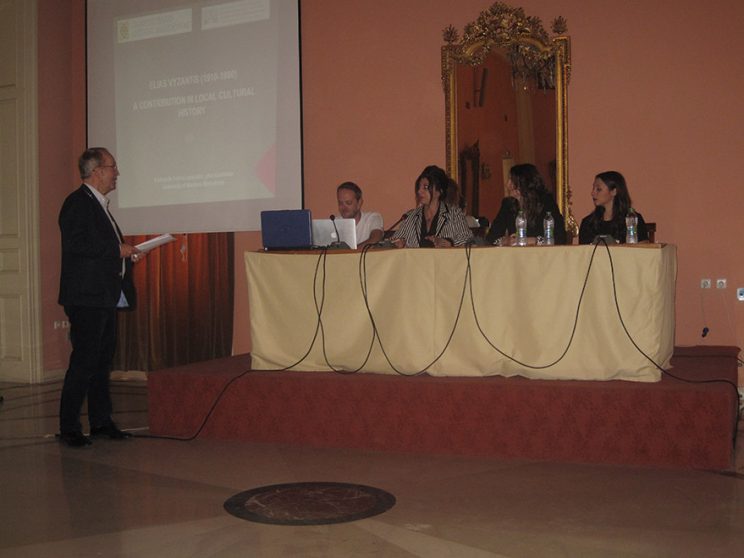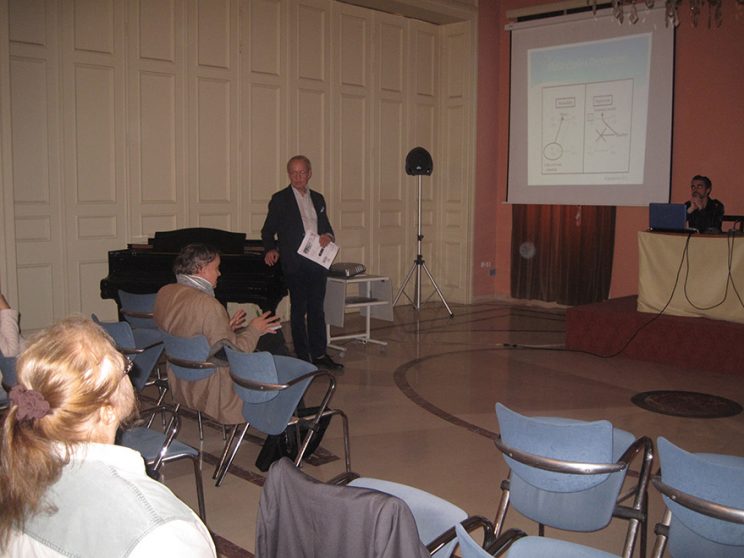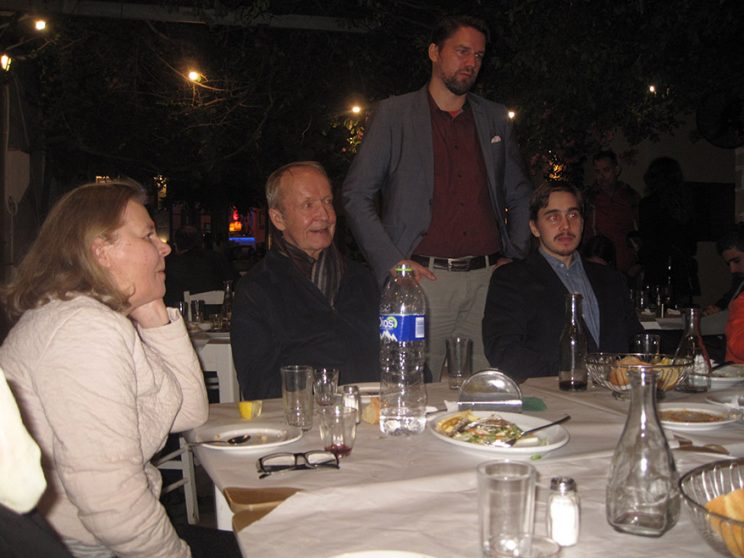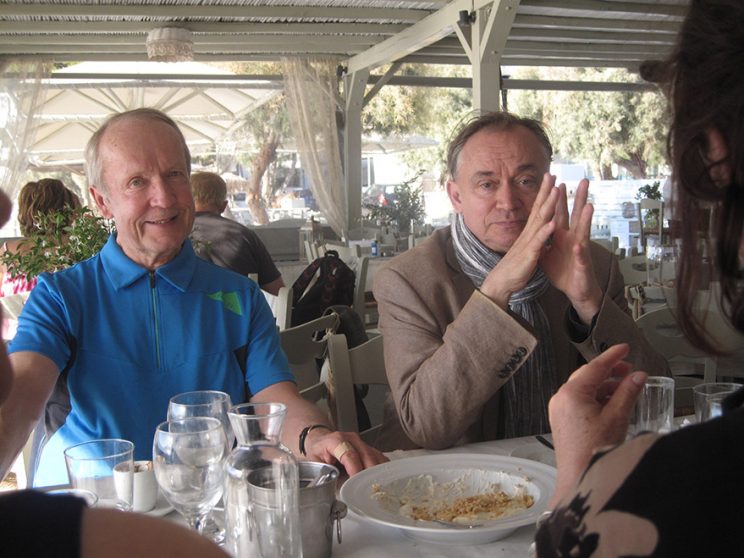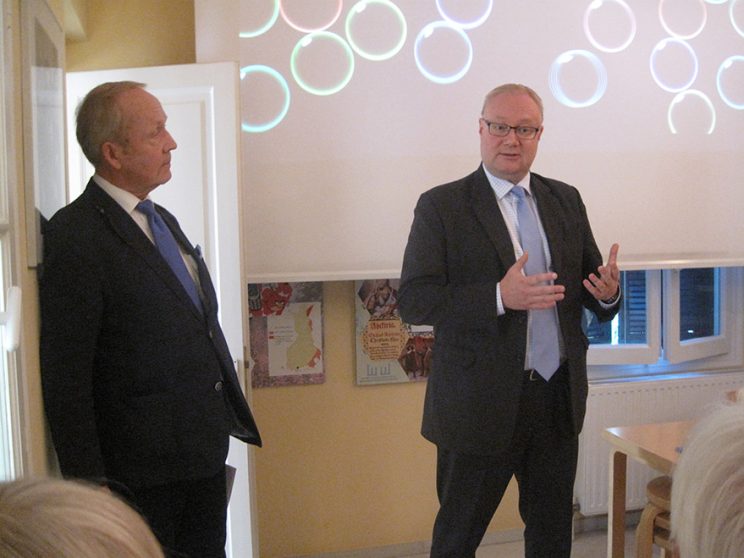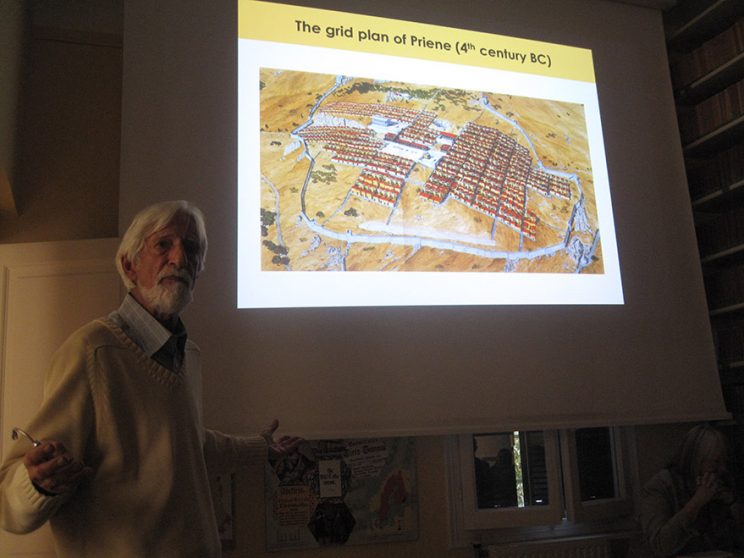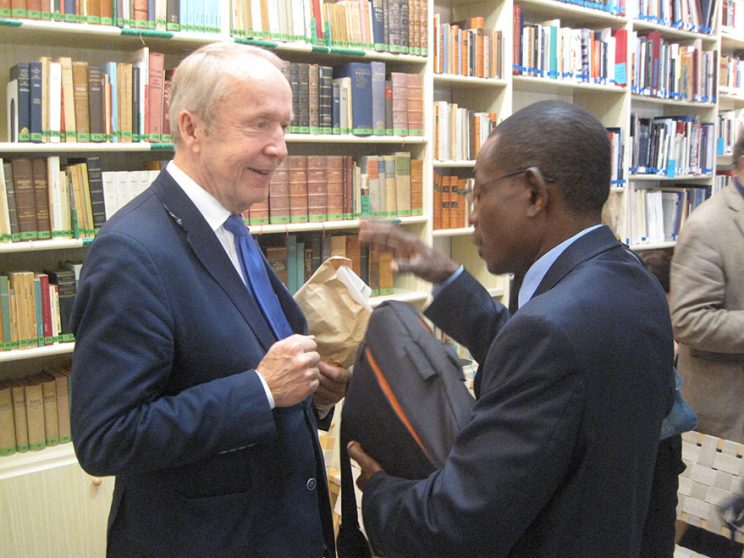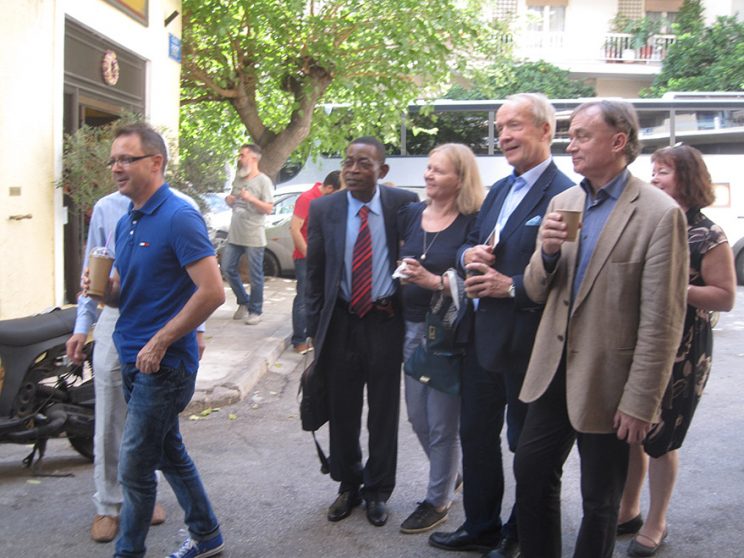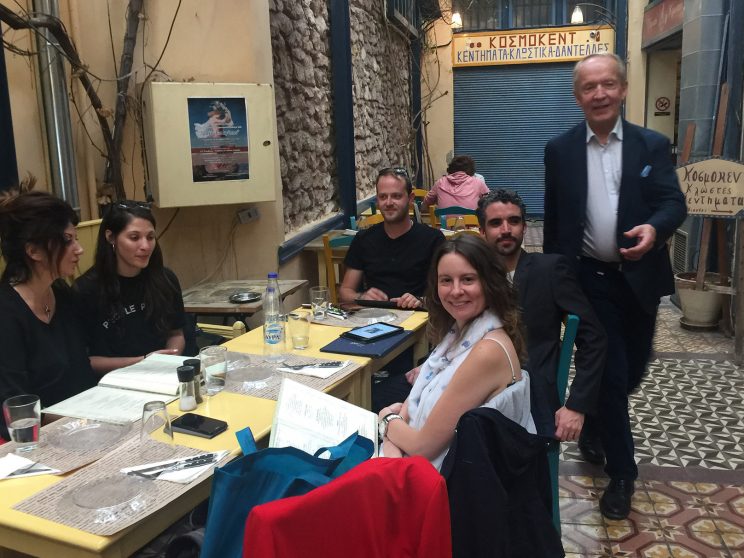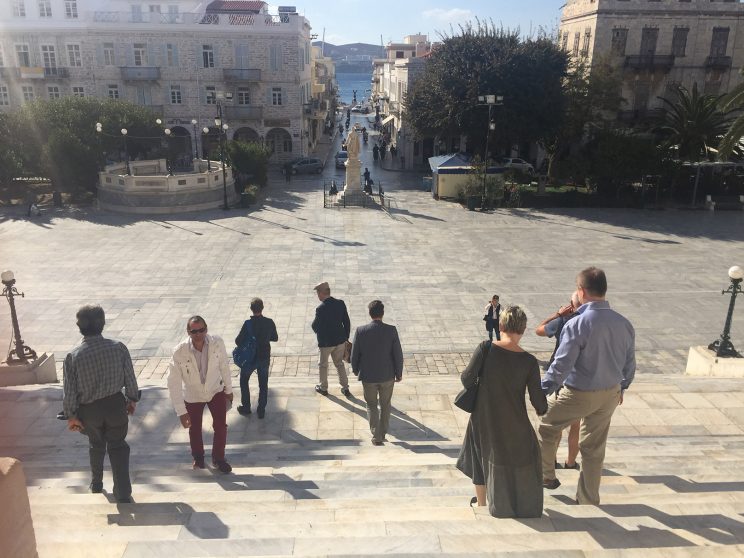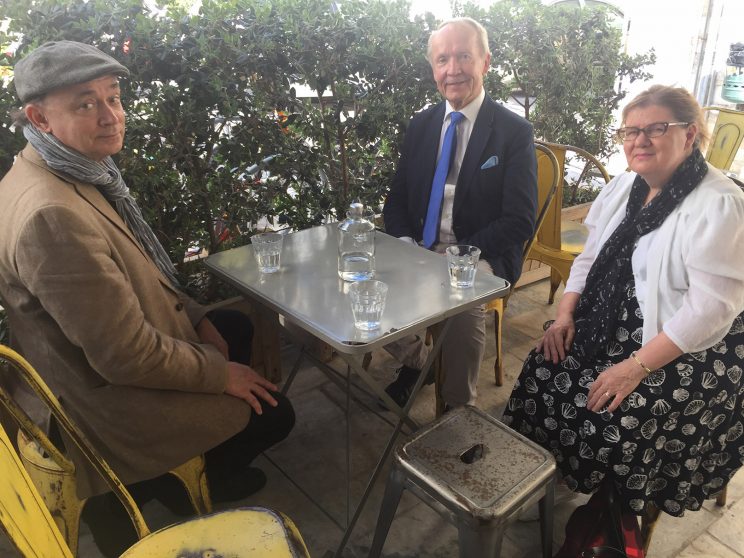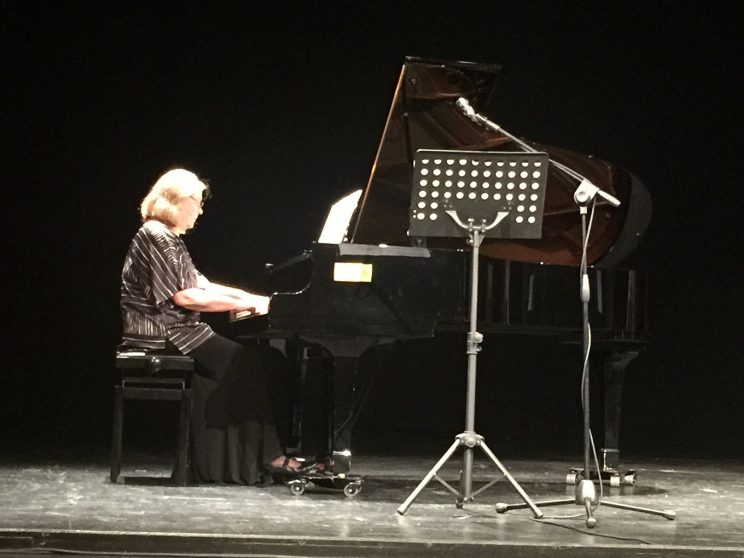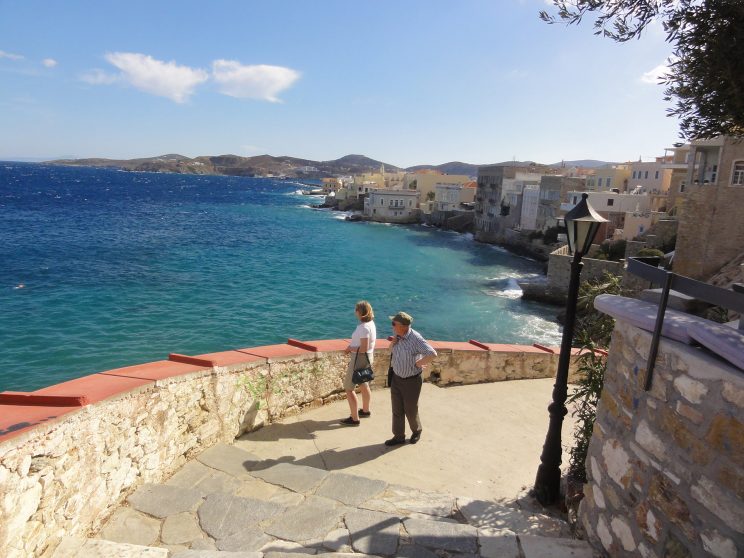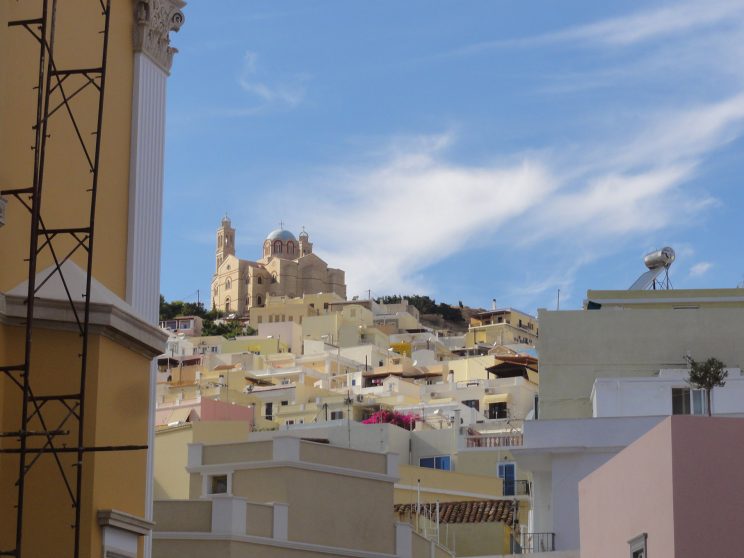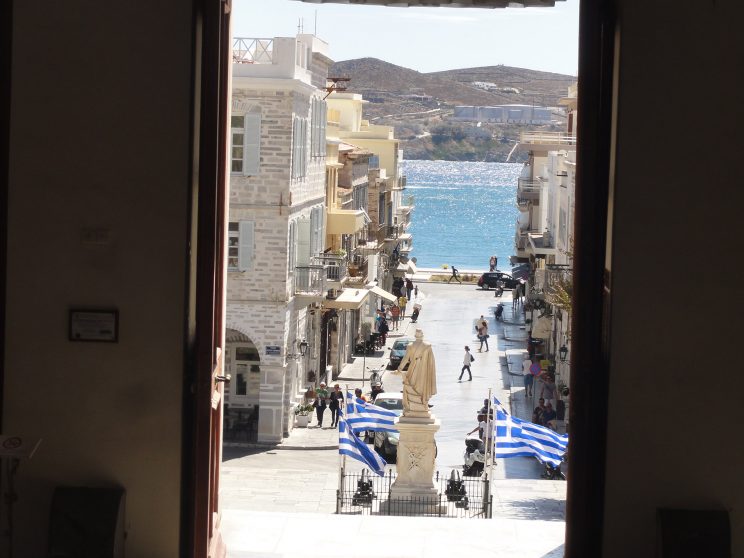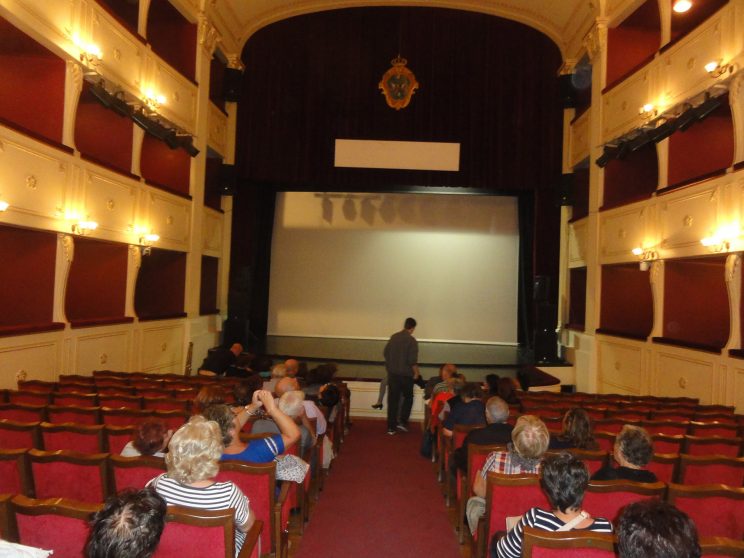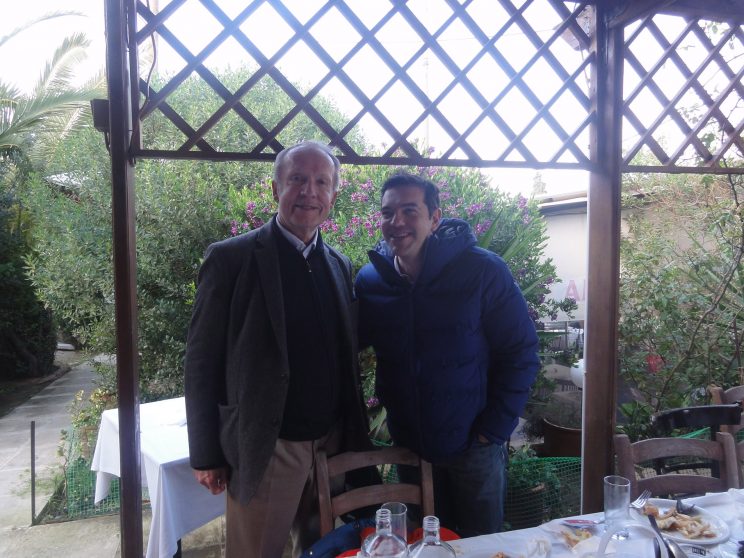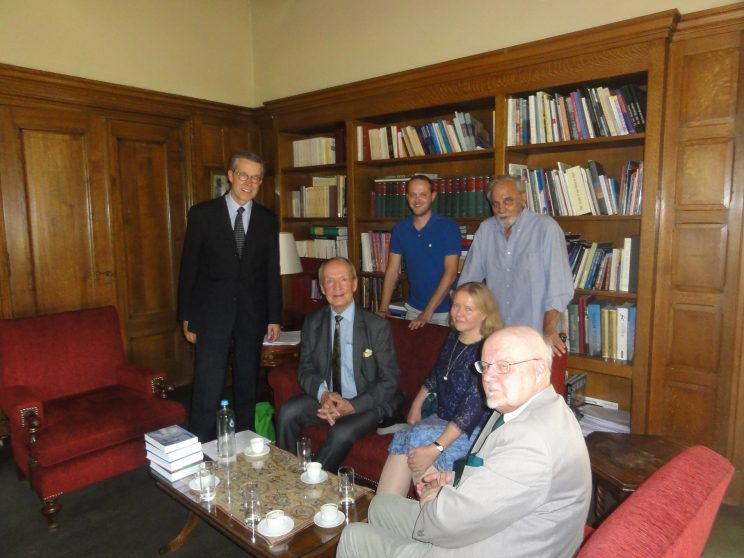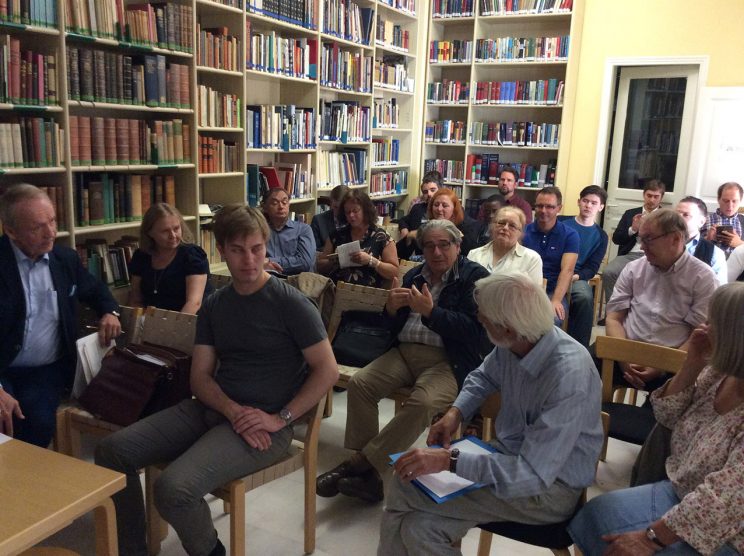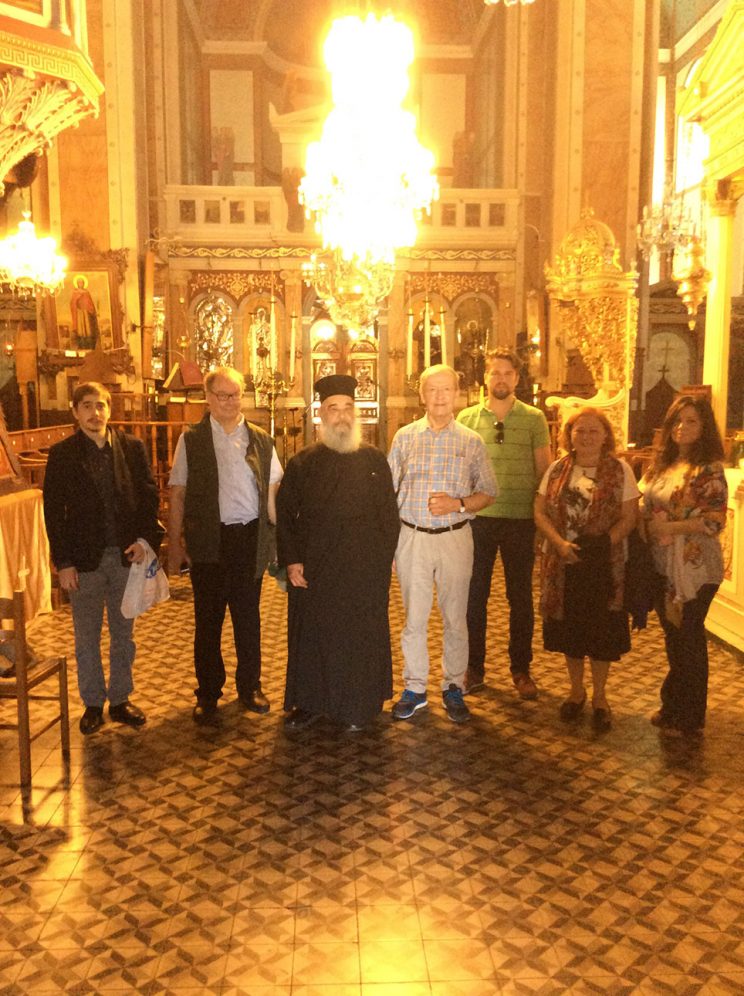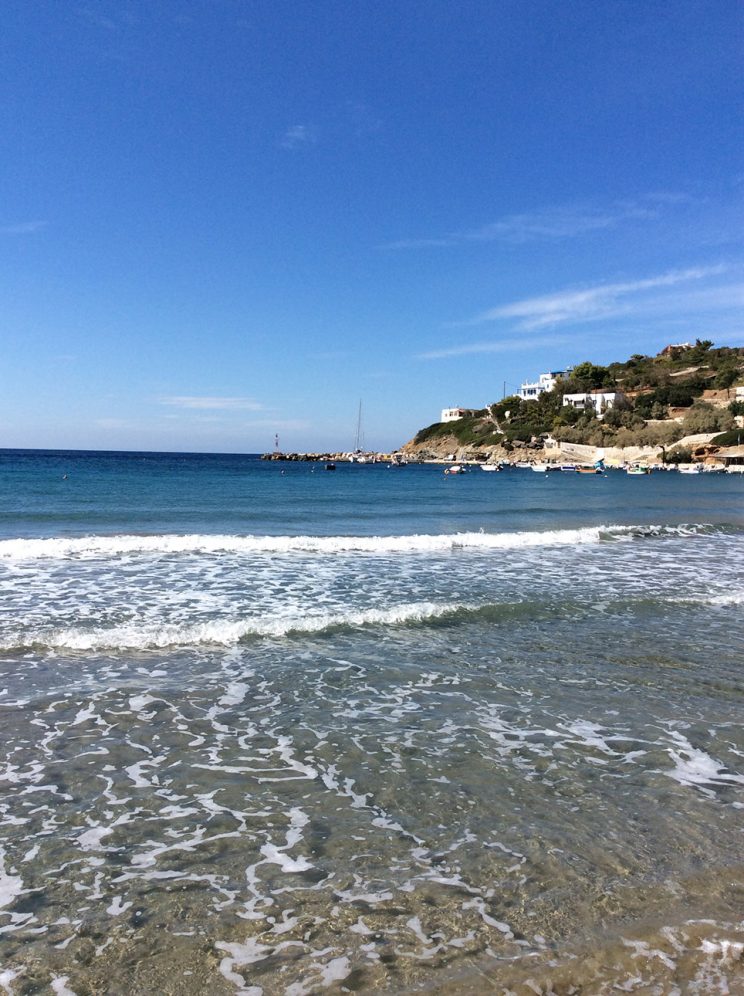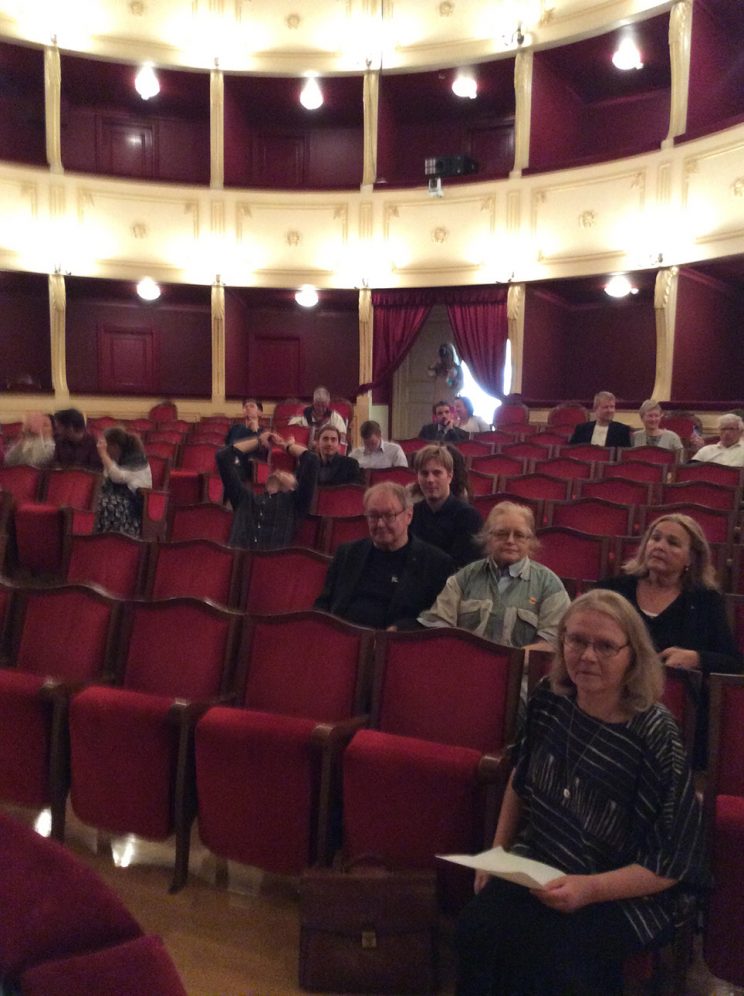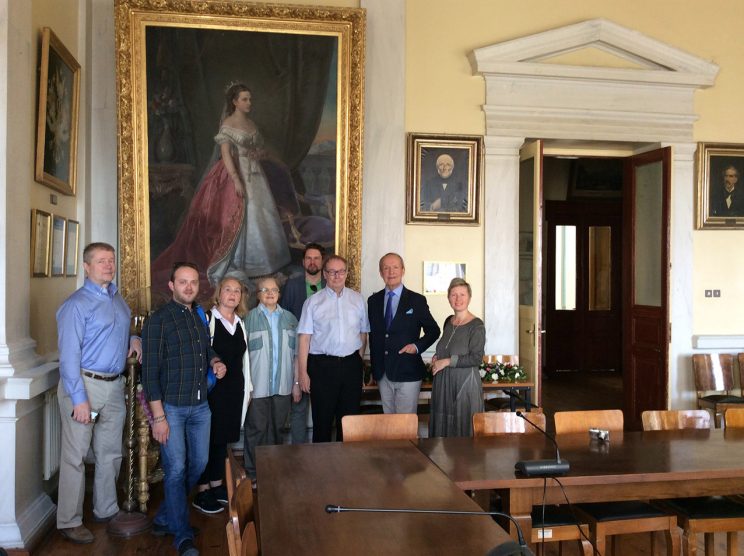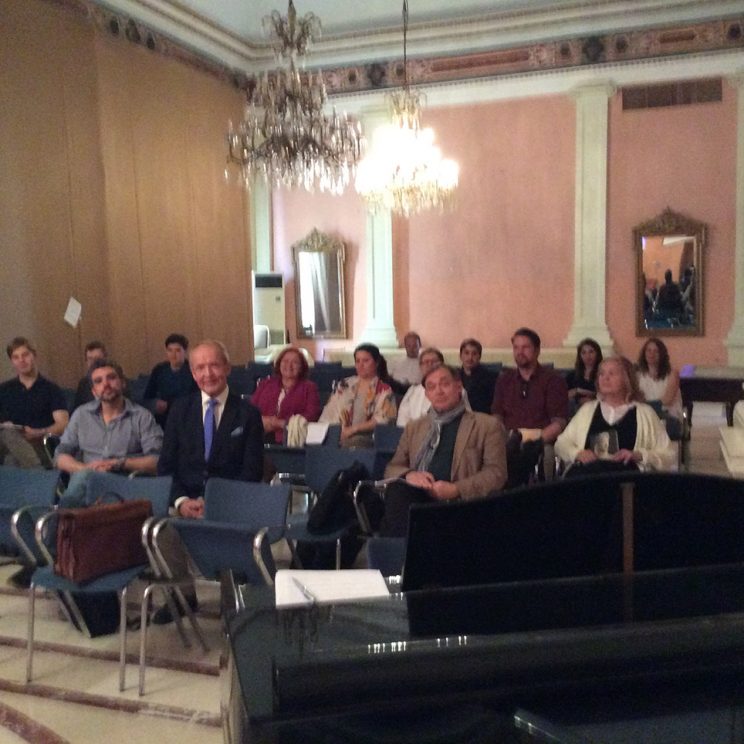The seminar was divided into two parts due to the availability of facilities at the Municipality of Hermiopolis, particularly its Culture Centre and Apollo Theater. A year ago our delegation had already visited Syros, met Mayor George Marangos and seen the places. The hotel Syrou Melathron was found as a most appropriate one and the Apollo theatre, a miniature copy of Milano’s La Scala, a fascinating place for music and other performances.
To get to Syros is easy via Athens, there are flights from many European cities which reach the capital so that all can get to the ferry boat leaving 7 p.m. and arriving at 10.30. p.m. The ferry is huge and convenient.
On Tuesday Oct. 3rd the seminar started at Ritsos hall of the Municipality, which is well provided with technology and a grand piano. The chair of the congress told about the background of the Academy, its activities so far, future plans and then about theoretical issues dealing with its research. He dealt with Greek philosophical sources in existential semiotics. The theme of the whole event was the “Greek miracle”, which meant Plato’s dialogues as the first effort in the history of mankind to discuss fundamental problems of human existence without a preestablished declarative goal by some divine authority. In what follows I give general lines of each speech in the seminar based upon my memory and notes during the seminar.
First, papers from the Finnish delegation of students and postdoc scholars from Helsinki University were heard. Sari Helkala-Koivisto spoke about autism as a non-existence introducing listeners to the semiotics of the disabled. This evoked strongly non-verbal signification. Her authorities are the Italian therapeuts and semioticians Stefania Guerra Lisi and Gino Stefani. Semiotics of disability leads us to the intra-zemic area, disability is a sign of diversity, it is a particular sense making. Basis of the human communication is in the non-linguistic continuous interaction. She argued, tht people exist behind the words. Existence is hidden under spoken words, where one is hiding his soul (Bene vixit quid bene latuit). Socrates thought of a dialogue as the basis in creating oneself and one’s surrounding culture. What is involved is reciprocal communal uncertainty. Communication is ability to be in dialogue with the one’s individual human self, it is continuous interaction and auto-communication. Autism has its own cultural reality: world of timeless space signified by non-signs. Autistic sign represents empirical transcendence.
Aleksi Haukka, doctoral student from Helsinki University, gave an existential semiotic analysis of the Spanish composer Fernando Sor. He had four parts in his speech: aesthetics and semiotics, existential semiotics, Fernando Sor and his music. Dahlhaus has said that anyone who asks about biographic reality is fallen into triviality. Yet, in the case of Sor one may distinguish M1= talent, vivacity, M2= musician, S2= soldier and S1 Values.
Tuukka Brunila, from Theoretical philosophy at Helsinki University, spoke about the notion of aporia and Socrates’ irony. Brunila noted that Socrates describes himself as someone who causes aporia. He gives his experiment of teaching geometry in Menon; a young slave is taught. The boy answers wrongly. Socrates makes him realize he is wrong. He does not know answers and he also realizes it. Irony lives between intention and meaning. What is said by a sentence is different from what a speaker is trying to say. Aristotle’s Nicomachean ethics discusses what appears to be good and what is desired to be good, i.e. opinion about the good. Socrates shows that what Meno says a virtue is, is not what he intends to say. So intention differs from meaning. People mean different than what he/she intends to say, Thrasymakhos states. Socrates’ irony means not what he says. Tragedy is when aporia disappears. It is impossible to know what you mean. Learning the truth is the same as aporia. Yet, aporia is beneficial. It benefits to know that one is ignorant of something.
Kim Keskiivari, likewise from philosophy at Helsinki University, dealt with transcendental acts in existential semiotics and their ethical implication for cultural heritages. He launched the Heideggerian idea of subject and Dasein, with its modalities of ‘can’, ‘must’ and ‘know’. Metamodalities were introduced as transcendental acts. What is going on with metamodalities, in terms of negation and affirmation? How can we understand cultural acts? Presence/absence is essential here. In Kierkegaard they are particularly relevant. There is contradiction between them like in the life of a Hegelian speculant who has built a huge palace of his system but lives himself in the side of it at a dog’s hut.
Thereafter, appeared the Greek delegation from Western Macedonian University, Florina. Professor Ifigeneia Vamvakidou introduced her team and defined how they understood the cultural heritage as material and immaterial culture. Cultural heritage is a tradition which still has a historical importance. Her doctoral student Tatiana Altini dealt with the Greek artist Vlassis Kaniaris and his installations during the Greek post-dictatorship period. She referred to his output in the 1950s and 1960s. He found her sources in theories by R. Williams’s Culture and Society 1958, Richard Hoggart, Edward Palmer, Thompson: The Making of the English working class, Jacques Derrida and Stuart Hallman as well as John Fiske. Kaniaris’s installations were in postdictatorship period icons of resistance, sign of human creativity. Whereas Evangelia Svirou spoke about Elias Vyzantis (1910-1980) and his contribution to local history. Her approach was a kind of micro-history and local history : events, proximities, subjects and changes. Names of places were almost Proustian in Florina. Elia Vysantis made signs in painting and inscriptions in stones.
Lazaros Papoutsis, doctoral student of semiotics of cultural practices at Aristotle University in Thessaloniki, is preparing a semiotic study of the origins and later development of Greek Olympic games. His analysis covered a long history of the event as well as its roots in the Greek philosophy of corporeality. Now Lazaros spoke about Olympic Games opening ceremonies, Athens 2004 vs London, 2012 and the semiotics of the Olympic Spirit.
“Olympic games are optimal portrayal of culture and cultural heritages, while promoting the values and traditions each hosting country represents. In this case, one may note Athens as capital of the Hellenic Democracy and London as Britain’s megalopolis.” Papoutsis focused on the semantic meanings of the ancient Greek spirit’s messages and symbolisms and on the semiotics structures, connotations and denotations of the industrialist representation of Western civilization through London’s Olympic manifestation. Through these multimodal ceremonies, he noticed the traditional historic model being incorporated by the official “senders’. Especially in the Greek case, the whole of the Greek history was represented in a linear fashion. Yet, the main goal is to find: a) the dominant visual images of Greece and G. Britain, b) the codes of these images, c) their symbolic meaning and d) their connotations and correlations with modern-day Greece and G.Britain. Papoutsis based his study on sociosemiotic methodology, which scrutinizes the texts as an integral part of a material and sociopolitical context. He observed the Olympics as a vehicle for promoting values as well athletic identities and social practices.
In the evening some participants gave a matinee concert at Apollo theater, open also for local people and tourists in the island. There Eila Tarasti told about the Finnish woman composer and symphonist Helvi Leiviskä; she has just published an extensive biography on her life and work (in Finnish, publications of the Academy of Cultural Heritages). She played also Sonatina by Helvi Leiviskä for piano, and three miniatures by the Finnish composer Carl Hirn. Then Daniel Röhe from Brazil performed by clarinet choros tunes from Rio de Janeiro. Aleksi Haukka played by guitar Heitor Villa-Lobos and Sor, and Eero Tarasti gave by piano some Villa-Lobos pieces: Prelude of Bachianas brasileiras n o. 4, Valsa da dor and Choros no. 5.
On Wednesday, Oct 4, the seminar continued in the morning by the speech of Daniel Röhe from the University of Brasilia; his field were psychonanalysis, psychotherapy and musicology. He dealt with myth of Oedipus pro viding it with intangible and tangible meanings i.e. movement from S1 to M1 in the existential semiotics, to which he largely referred. He also mentioned Medar Boss’s visit to Totenauberg at Heidegger in 1949, and Heidegeger’s stay in Zürich. He mentioned his Brazilian mentor Francesco Martins and his remarkable output. Dasein is contact with other. He said that Tarasti expands Dasein to Others and objects. Must-be and can-be refer to Robert Musil. He quoted Avicenna’s notion of cure. Röhe tried to use the zemic model for clinical implication and psychopathology. Thus he dealt with thymopathies, i.e. thymos = mood and pathos = disturbance of the thymic level. So melancholy represents an isolation i.e. gap between Moi and Soi. There S2 is missing in the zemic movement from M1 to S1.
Neuroses again stem from neuros + osis; like phobia from phobos, hysteria i.e. obsession, neurosis. The symptoms that appear are suppressed to hide the real kern of the disease. When all is fine, we are not aware of ourselves. Perversions are the negation of neurosis (Freud); pleasure of its use (sadism, masochism, fetichism, sadomasochisms) stems from denying the Soi. According to Heidegger the duty is an exemplary assertion.
Dimash (Dinmukhammed) Suleimen from Kazak National University of Al-Farabi, Almaty, being granted for doctoral studies at University of Helsinki, dealt with axiologies and epistemic foundations of Kazak culture. He introduced recent reforms of Kazak culture like the change of writing from Kyrilic alphabets to Latin. He also dealt with present popular culture in Kazakstan in the form of the singer Dimash, extremely popular in China, where he represents the close contact between these countries.
For the lunch the seminar moved to Kini village’s beautiful beaches, continued its discussion on the smooth waves ot the Aegean sea and during the lunch time. In the afternoon, the congress travelled by ferry boat to Athens, admiring at the deck the fabulous landscapes and a sunset on the Greek islands and Eastern coast.
Thursday, Oct 5, the seminar started in Athens at Finnish Institute. It was opened and wished welcome by the Finnish Embassaor Juha Pyykkö.
The first speech was given by the remarkable Greek semiotician, professor of urban planning and architecture from the Aristotelian University of Thessaloniki, Alexandros Lagopoulos. He spoke about ancient Greek semiotic system of urban space. The basic myth of it is the labyrinth of Minotaurus and Theseus. The same pattern was found in coins, walls and plague of Knossos in 1200 B.C. like also in the shield of Achilles, Omphalos. It represented with its circles Dance, sleep, earth, sun, moon and stars. It created harmonic sounds of Zethos; Amfion had seven gates to heaven and seven tones. Serpent was the symbol of the sky and earth or Eos. Spartoi kill each other, so serpent must be led in order to found a city on the slope of Ethna. Killing of dragon in order to found a cityi.e. make chaos disappear. Lagopoulos presented dichotomies under titles of Hestia and Hermes: female/male, dark/light, immodest/modest, permanent/ transcending, fixation/ dynamic, internal space/external space. So the center of the world was created. The omphalos of Delphoi. Anaximander drew the world map where Delfoi was the center. Pythagorean philosophy introduced primordial elements of earth, water, fire, sky which were represented by numbers, the ideal number being 10: 1,2,3,4. Greeks created the ideal city or city-state, Akropolis as its center surrounded by sacred sphere and sphere of artisans. Number series 8,4,2,1,3,9,27 had its meaning. Furthermore, Plato had the idea of Atlantis. What was the impact of the Greek system upon the human mind? It created three classes: cosmic harmony, cosmic semantics and hegemoniac ideology. The Greek system, to Lagopoulous’ mind, was analogous to later semiotic theories such as by Lotman and Greimas.
After Lagopoulos, we heard another speech on Greek Architectural theory and heritage by Dr Nikolaos-Ion Terzoglou from Athens. He dealt with the idea of a monument. What is historical monument, is not a natural fact. History and memory are linked. Ruins of a Roman theater: John Ruskin wrote his classical study: Lamp of Memory and Seven lamps of architecture. Painting an Ancient Rome as a palimpsest in 1762. The Parthenon in 676. Monument is not an object, – just as John Deely said: sign is not a thing. Historical monuments are unintentional. Monument is subject. Let us recall Alois Riegel. Ideal reconstruction of Athens. Antiquity was seen as utopia. Collingwood had the idea of history. J. Schlobach presented the Zyklentheorie. The concept of monument was elaborated by Max Weber, as an ideal type: 1) as a concrete object, having individual curiosity and pleasure, an aesthetic reception of the remnants of the past, 2) abstract, general field, as public knowledge. Of this one can only say that art works are not done in order to be signs of the past.
Prof. Altti Kuusamo talked about the powerful continuity of Images: Tykhe (fortuna)c and Nike (Victoria) in the European Visual Scene, from the A ncient Greece to the Present Day.
Prof. Demetre Yannou is a musicologist and for a long time chair of music at Aristotle University of Thessaloniki, one of the creators of Erasmus network of many a musicological institute in the Europe. He spoke about music in the ancient Greece. Greek arithmetics calculated intervals, numerical identities of tones based on numbers 1 and 3, and helping then tuning and leading in Bysant to invemtion of organ. The great question is to which extent the impact of tragedy depended on music. The exact pitch cannot be defined. Note Nietzsche’s later theory of Apollonian and Dionysian art.
Dr Samuli Salmi, from Helsinki University, philosophy and medicine, went back to the origins of Greek medicine. It was understood as paideia, and central role was played by Pythagorean school and some other precursors of Plato like the Sicilian school. Herakleitos said that nature loves to hide. There was impulse of natural philosophy; Except the blind forces in nature, nothing moves in the world. A rational system separated the medicine from superstition. The illnesses inventoried were epilepsy, apoplexy, dilusion, madness and impotence. Ionian rationalism taught that human beings are made of same substance as cosmos, physis leads to general or practical physical constitution of reality of a patient. Pythagor and Alcacon of Croton exercised their influence on Hippocrates school. Health consists of a state of balance. The idea of order was based upon the distinction limit/unlimited. So can we ask what is illness? Disturbance. Of What? So what is normal? We can speak of endosigns of illness. Diagnostic inference is central. Diagnosis is not only proof of knowledge but test of meaning. The worst the physician is the most ‘logical’ in his therapy. Ludwig Fleck 1896-1961 was pioneer of fuzzy logics in medicine. Medical diagnoses are not result of logical thinking. Symptoms are vague and indeterminate. Medical doctor leans on the intuition in diagnosis.
In lunch, I spoke with Lagopoous and Yannou about Thomas Sebeok and his role in semiotics, as well as of his many visits to Greece.
After lunch Dr Karin Boklund started by telling about ancient Greek cultural heritage in the European literature. How ancient cultural heritage is understood and received was her main question. Physical artifacts and intangible attitudes of a group that are inherited, are maintained in the present and bestowed for the benefit of future. What to preserve from the past? Impact of Greek culture on Roman was enormous. Aeneas, future founder of Rome, Ancient Greeks are Roman pagan culture, like the gold of Egyptiann. Pagan gods were reinterpreted as planets. The story of Troya was told. Form of beauty was discussed by Plotinos whose cosmology tells that body must transcend and find its origins. Absolute beauty was herited by Petrarca, and neoplatonian love was again applied. In France emerged the neoclassical drama. Language was embellished. In the painting from 1787 Death of Socrates the ancients are differently dressed than others. Lord Byron 1788-1824 visited Greece; John Keats wrote an ode for Greek 1819. Beauty is truth, griechische Heiterkeit. One may study le retour aux mythes grecques in France in the 1920s. Neoclassical psychology? Plato was portrayed as a contemporary man. Why mythological form was needed?
After Boklund-lagopoulos we stayed in literature since professor Pirjo Kukkonen spoke about the Finnish-Swedish writer Göran Schildt (1917-2009) and his Odysseia with the boat Daphne in the Mediterranean in 1948-1984. Odysseus’ ship is a metaphor of a journey to the mythical life and the unknown. Gods are present there: Hermes, Poseidon, Athena; Circe and Cyclops are symbols of foreign shortcomings. Combination of human and divine is present there. Why sailing? Water is a vital necessity. Whole Greek miracle lays on the Homeric ground. Goethe’s Italian journey, thalatta experience by Emil Zilliacs who had made a pilgrimage to Hellas in 1923. Just to learn about ‘myself’, as he said. Schildt also travelled in Italy in steps of Goethe with Finnish philosopher Georg Henrik v. Wright. He wrote about André Gide and Alvar Aalto. European culture has its roots in the mediterranean countries; Culture is an existential question to Schildt.
Dr Ivo Velinov from Bulgaria, New Bulgarian University in Sofia, had a speech about Plato’s Republic, shaping cultural heritage in parallel worlds. He had three parts: meaning of ideals, the contemporary, notion of ideals and the place of ideals (dramatis personae). Plalto’s Book III, Republic: what an ideal is cultural heritage? The best in culture i.e. those which are held best, which fulfill aim, they constitute excellent situation and characteristic person. Paideia leads to education. John Ruskin spoke about it in his Sesam and Lilies. There are different meanings. First, practical one i.e. subject is based on schooling, virtues, i.e. European values. The Greek idea of paideia was carried by aristocratic class. Culture and youth are ‘molded’ to the ideals, beautiful and good, kalos, and agathos. Ideal is a transcendental notion. Moi is ‘molded’ into demands of ‘Soi’ we could say.
Svetlana and Markku Toivakka from Helsinki, brought then to the seminar their experience in the architecture of renovating and revising an old vicary house in Finland as an effort to preserve its inherent cultural values.
Kalliope Stiga, musicology doctor from Athens introduced her expertise in the studies of the Greek iconic composer, Mikis Theodorakis. The theory of Theodorakis was formed in 1941-43. He accepted Christianity and Marxism and became exponent of social justice. Behind him was another idol Costis Palamas (1859-1944), who had the ideae of a rhythmic walking, rhythm that governed the universe. 1960 he was in Athens and became music composer. It was time of social unrest, he promoted music for the masses and became marxist and leninist and generator of mass culture. He wanted to found modern Greek popular music and modern Greek poetry as the mirror of people and art. Poetry/Melos corresponded to Byzantine /demotic distinction. He wrote the Song of the Dead Brother in 1960-63. Civil war, Zorbas the Greek appeared in 1964. Then started the utopian project of Thedorakis. Canto Olympico is from 1992. He wrote also comic opera Antigone and Lysistrata 2000-2001 where he declared: Good is not dead! Important moments were new regime in Greece 1974- and Sweden 1986 and Athens in 1999.
Saturday Oct 7, opened with a speech by professor Jean-Claude Mbarga from Yaoundee, Cameroun, on the conspectus of the coordination of cultural heritages in the continent of Africa. He wanted to promote the idea of multiculturality, and the exchange of cultural heritages between continents via a data base and promotion of cultures. He had thought for Africa as its centers of this movement Cameroun, South Africa, Marocco and Senegal. He wanted to nominate national representation of the continent for all coordinators. The movement should be based upon valorization of national languages and immaterial heritages: habits, practices, knowledge, rites, oral traditions and patrimonies. So the projet looked very mucuh same as once the programme of the International Semiotic Institute in Imatra. Prof. Mbarga had been already interviewed by a French magazine of his projects. His speech evoked a lively discussion how the Cultural Academy should proceed in future, whether, say, a list of preservable cultural heritages in each area should be made in which quite concretely the scholars of the project should focus. Daniel Röhe proposed to make similar coordination for Latin America.
Kristian Bankov arrived from Bulgaria, Sofia, from the New Bulgarian University, where he is running the historic Institute of South-east European Center of Semiotics. He spoke about Aristotles’ theory on money. The Greek mind namely invented the coin; Bankov represents now commercially oriented semiotics. What semiotics can learn from economic aspects? He gave us an ultra-short history of money. Before money in 9000-6000 BC there was cattle, in 1200 BC…. 1000 BC metals, in 687 BC coins, in 1661 entered bank notes, 1959 credit cards, XXI digital money. Money and early Greek mind: coins with objective value was base on social contract. Coins are fungible, better for thinking, one does not need to weight every coin separately, for calculation. In that aforementioned linear development was realized the principle of arbitrariness betweem value and medium. Yet, money is not infinite like linguistic signs; Azteks did not use money. There is scarcity, limitation with money.
At the end Deniz Özden from Istanbul gave a lecture on a bronze statuette playing a trumpet in ancient Greece. Such statuette are now found in British museum BM 130. 909. They are male figures playing trumpet; there is an interesting instability of posture. Bronze statuttes were gifts to the dead. Louvre has also Ephesos statuettes, from Central Anatolia. Mylaza bronze statuette resembles of the kithara player. They evoke Amfion in the early iron age (880 BC), and aulos players. So they constitute a music archaeological problem of their nature.
Prof. Yannou gave after Özden’s speech a long comment on the basics of wind instruments. Particularly the technic of blowing reveals a lot of the function of these instruments. Perhaps one could play polyphonically with them. Artistic style was obviously barbarous and grotesque. Hornbostel made a classification of bones used as maerial. The musicians used there a leather bell to help blowing.
Mikko Metsälampi, a student of musical semiotics and theory from Sibelius Academy and University of Helsinki, ended the seminar with his speech on music as order, Chopin’s etude c-sharp minor op 27 no. 7 as an illustration. He dealt with the sense of time, and put the cases of B-time, the absolute time and objective time as external to perception, and A-time which was experienced time and subjective. Where dwells process of becoming, musical order, has been studied by Byron Almen a.o.
On Sunday, Oct 8, the whole seminar visited Akropolis and thereafter the Archeological Museum of Athens.
— Eero Tarasti
